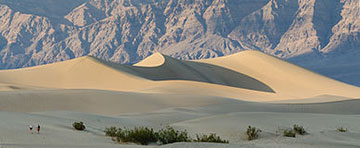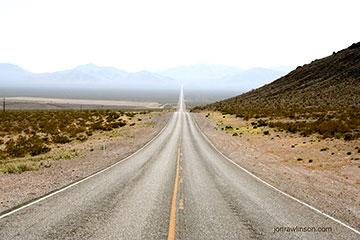Yesterday’s post sparked a memory about Death Valley …
My late father-in-law, Ivan, loved to tell us about traveling across Death Valley to visit relatives, stationed on an Army base in California. He was born in 1910, so that might have been in the early ’20s. At that time, there apparently were no proper roads across the valley, but folks had discovered they could cut off a few hours’ time traveling southwest if they braved the Mojave Desert on their way to the coast.
So enterprising engineers devised a makeshift “road” of two narrow wooden slats over the sand, and Ivan’s family drove their Model T carefully on the boards, taking care not slip off one side or the other (talk about driving attentively!). And since a slip or a breakdown in the Mojave Desert’s extreme temperatures could be fatal, mounted men regularly patrolled the route (early highway patrolmen?).
Death Valley is located on the border between southeastern California and Nevada and covers a 3,000-square-mile area. It’s the lowest, driest, and hottest area in North America. (It’s also bordered by Mount Whitney, the highest point in the contiguous U.S.). Consequently, it’s set lots of records: the highest recorded temperature on Earth (134°F), the greatest number of consecutive days over 100°F (154), the hottest daily low temperature ever recorded (107°F), the hottest 24-hour average temperature (117.5°F), and even the hottest overnight low (107°F). Not a place you’d want to get stranded.

Photo by Tuxyso via Wikimedia Commons
Today, California SR 190 travels through Death Valley, following the gold-rush path of 1849. A man named Herman Eichbaum was instrumental in creating a toll road through the valley in 1926, bringing tourism to the area. But I couldn’t find information about either the primitive wooden-slat route my father-in-law talked about or the early highway patrolmen. Maybe a similar story has been passed down in your family? Tell all!

Photo by Jon Rawlinson via Wikimedia Commons





















































I am enjoying these facts about Death Valley the past two days. It has always been a mystery to this east coast girl about such a hot and dry place and I admit I would love to go see the place for myself. Can you imagine trying to cross on wooden boards in the 110 degree sun in a old Ford? Talk about brave and scary! I bet your father-in-law was telling the truth. It does make perfect sense to craft something like they did back in the 1920s but my guess is that the risk meant very few people were able or willing to try using the route. Those old Model T Fords completely opened the world to everyday people and Henry Ford was a genius when he made it a goal to price them so they were more affordable to everyday folks.
When I lived in India, it was commonly 120+ degrees in the hot season in Rajastan. The Indians dealt with the high heat by serving very sweet drinks of mango and such fruits, but salted it . You couldn’t taste the salt and you could drink them all day, really helped with the dehydration.
I mostly lived in the cool Himalayan mountains, luckily.
The hottest place I have ever been in was in Kuwait. It was 130 degrees according to the airport and we had to wait until nightfall for the temperatures to lower enough to have lift off for the planes. Every building in that country is heavily air conditioned. It like going into an icebox. You come in from 120-130 degrees and its like 65 inside, just amazing. They really like it cold!